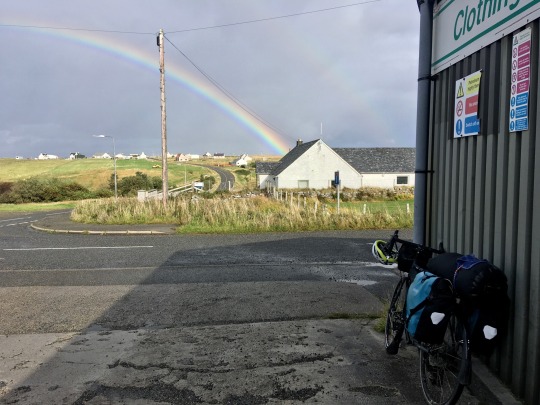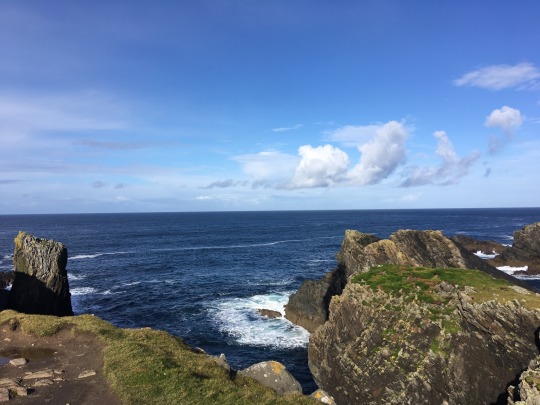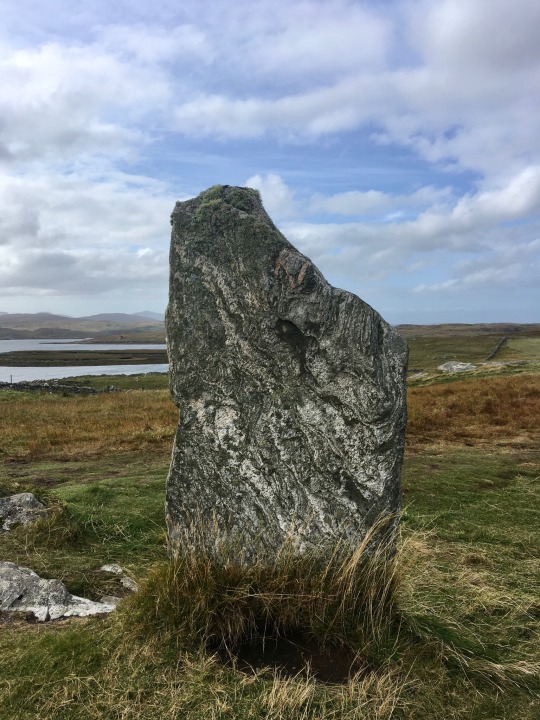#bostagh beach

The final push to Lewis began with a ridiculous climb into an alien landscape of vast, smooth bare mountains and slate-grey lochs. Yellow snow poles flanked the road, bent in wild directions by the ferocious wind. We came through a small pine forest – virtually the first trees we’ve seen on the Outer Hebrides – and ate square sausage sandwiches in their shelter. Half the square sausage had ended up splattered over M’s trousers as we cooked on a wobbly boulder the night before, and he smelled like a fry-up.
The clusters of homes became hamlets, then sizeable villages, and finally the sprawling edges of Stornoway: the biggest town we’ve seen for weeks. It had an Argos! We nipped to MacLeod & MacLeod butchers for some of their famous black pudding, and then took the long road across the barren moors, towards Lewis’ most northerly point. The wind pushed us along to the Butt of Lewis lighthouse. We cooked the black pudding to celebrate making it to the official end of the Hebridean Way, and kept M’s trousers well out of reach this time.


Going back against the wind was a horrible slog. Squally showers kept dousing us, but when they stopped there would be a fantastic rainbow somewhere in the stormy sky. We passed shops with sets of rusty trolleys in their tiny car parks, and a man refuelling his tractor at the single petrol pump. Turning off towards Shawbost, we leaned even more deeply into the wind. High hills rose on the horizon, blocking the view of the sea. We passed an enormous whalebone arch and then, exhausted, pulled up at our AirBnB on a working croft.
Siaron and Keith, who out were feeding the chickens in their tornado-proof run, looked after us like we were family. They put M’s trousers in the wash and made up the most comfortable bed ever. I was fast asleep by 8.30pm. We had breakfast together, listening to their stories of transporting their entire smallholding – including sheep, horses, dogs and a single goose – over on the Stornoway ferry. To be a proper islander you had to last three winters, Siaron had been told. It was barely autumn and I was ready to call it a day.
We set off into the howling wind once again, cycling through a landscape steeped in history. We saw the reconstructed Norse Mill and Kiln, reminders that Viking raiders settled on Lewis and stayed for 350 years, and then found the Neolithic Callanish Stones. They are 500 years older than Stonehenge, with a circle of stones surrounding a chambered tomb and then four avenues branching off in the shape of a crucifix. Until the 1850s they were covered in five feet of peat, but they now stand tall and proud up on their bluff.


Our last stop was Bernera, a tiny island with a bridge over the Atlantic to get there. Cycling up a hill with a rocky cliff-face beside us, I heard a squeaky cry and then a golden eagle flew over me about ten metres away – absolutely massive, with fierce yellow talons. M was waiting at the top of the climb, looking in the other direction. “Eagle! Eagle!” I shrieked from down the road. He turned just in time to see it settle on a ledge a few metres from him. It was magical to see it so close up, and we spotted it, or another, a few more times as we creaked to Bostagh Beach.
After both getting off to push our bikes up one of the steepest roads I’ve ever seen, we reached Bostagh. By a picnic bench, in a little sheltered dip, was the most perfect tent-sized patch of flat grass. The tide was in and only a sliver of the white-sand beach was visible, with a tide bell mounted on a seaweed-covered rock. Beyond was the turquoise sea. Nothing but ocean until Canada, its rocky shores hidden away by the curve of the Earth, which my Taid taught me when I was little. Rain blew across. When it stopped, the end of the rainbow came down right outside our little tent.


Read the next Island Hopping blog: Autumn in the Highlands

Really wild camping. Bostagh Beach, Scotland
